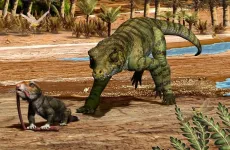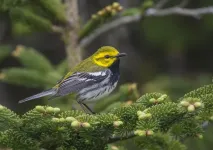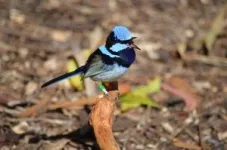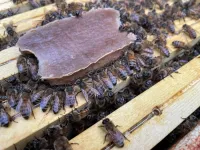(Press-News.org) Kyoto, Japan -- There's a sensation that you experience -- near a plane taking off or a speaker bank at a concert -- from a sound so total that you feel it in your very being. When this happens, not only do your brain and ears perceive it, but your cells may also.
Technically speaking, sound is a simple phenomenon, consisting of compressional mechanical waves transmitted through substances, which exists universally in the non-equilibrated material world. Sound is also a vital source of environmental information for living beings, while its capacity to induce physiological responses at the cell level is only just beginning to be understood.
Following on previous work from 2018, a team of researchers at Kyoto University have been inspired by research in mechanobiology and body-conducted sound -- the sound environment in body tissues -- indicating that acoustic pressure transmitted by sound may be sufficient to induce cellular responses.
"To investigate the effect of sound on cellular activities, we designed a system to bathe cultured cells in acoustic waves," says corresponding author Masahiro Kumeta.
The team first attached a vibration transducer upside-down on a shelf. Then using a digital audio player connected to an amplifier, they sent sound signals through the transducer to a diaphragm attached to a cell culture dish. This allowed the researchers to emit acoustic pressure within the range of physiological sound to cultured cells.
Following this experiment, the researchers analyzed the effect of sound on cells using RNA-sequencing, microscopy, and other methods. Their results revealed cell-level responses to the audible range of acoustic stimulation.
In particular, the team noticed the significant effect of sound in suppressing adipocyte differentiation, the process by which preadipocytes transform into fat cells, unveiling the possibility of utilizing acoustics to control cell and tissue states.
"Since sound is non-material, acoustic stimulation is a tool that is non-invasive, safe, and immediate, and will likely benefit medicine and healthcare," says Kumeta.
The research team also identified about 190 sound-sensitive genes, noted the effect of sound in controlling cell adhesion activity, and observed the subcellular mechanism through which sound signals are transmitted.
In addition to providing compelling evidence of the perception of sound at the cell level, this study also challenges the traditional concept of sound perception by living beings, which is that it is mediated by receptive organs like the brain. It turns out that your cells respond to sounds, too.
###
The paper "Acoustic modulation of mechanosensitive genes and adipocyte differentiation" appeared on 16 April 2025 in Communications Biology, with doi: 10.1038/s42003-025-07969-1
About Kyoto University
Kyoto University is one of Japan and Asia's premier research institutions, founded in 1897 and responsible for producing numerous Nobel laureates and winners of other prestigious international prizes. A broad curriculum across the arts and sciences at undergraduate and graduate levels complements several research centers, facilities, and offices around Japan and the world. For more information, please see: http://www.kyoto-u.ac.jp/en
END
Your cells can hear
Uncovering the relationship between life and sound
2025-04-16
ELSE PRESS RELEASES FROM THIS DATE:
Farm robot autonomously navigates, harvests among raised beds
2025-04-16
Strawberry fields forever will exist for the in-demand fruit, but the laborers who do the backbreaking work of harvesting them might continue to dwindle. While raised, high-bed cultivation somewhat eases the manual labor, the need for robots to help harvest strawberries, tomatoes, and other such produce is apparent.
As a first step, Osaka Metropolitan University Assistant Professor Takuya Fujinaga has developed an algorithm for robots to autonomously drive in two modes: moving to a pre-designated destination and moving alongside ...
The bear in the (court)room: who decides on removing grizzly bears from the endangered species list?
2025-04-16
By Dr Kelly Dunning
The Endangered Species Act (ESA), now 50 years old, was once a rare beacon of bipartisan unity, signed into law by President Richard Nixon with near-unanimous political support. Its purpose was clear: protect imperiled species and enable their recovery using the best available science to do so. Yet, as our case study on the grizzly bear in the Greater Yellowstone Ecosystem reveals, wildlife management under the ESA has changed, becoming a political battleground where science is increasingly drowned out by partisan ideology, bureaucratic delays, power struggles, and competing political interests. ...
First study reveals neurotoxic potential of rose-scented citronellol at high exposure levels
2025-04-16
Citronellol, a rose-scented compound commonly found in cosmetics and household products, has long been considered safe. However, a Korean research team has, for the first time, identified its potential to cause neurotoxicity when excessively exposed.
A collaborative research team led by Dr. Myung Ae Bae at the Korea Research Institute of Chemical Technology (KRICT) and Professors Hae-Chul Park and Suhyun Kim at Korea University has discovered that high concentrations of citronellol can trigger neurological and behavioral toxicity. The study, published in the Journal ...
For a while, crocodile
2025-04-16
Most people think of crocodylians as living fossils— stubbornly unchanged, prehistoric relics that have ruled the world’s swampiest corners for millions of years. But their evolutionary history tells a different story, according to new research led by the University of Central Oklahoma (UCO) and the University of Utah.
Crocodylians are surviving members of a 230-million-year lineage called crocodylomorphs, a group that includes living crocodylians (i.e. crocodiles, alligators and gharials) and their many extinct ...
Scientists find evidence that overturns theories of the origin of water on Earth
2025-04-16
Images available via link in the notes section
University of Oxford researchers have helped overturn the popular theory that water on Earth originated from asteroids bombarding its surface;
Scientists have analysed a meteorite analogous to the early Earth to understand the origin of hydrogen on our planet.
The research team demonstrated that the material which built our planet was far richer in hydrogen than previously thought.
The findings, which support the theory that the formation of habitable conditions on Earth did not rely on asteroids ...
Foraging on the wing: How can ecologically similar birds live together?
2025-04-16
UNIVERSITY PARK, Pa. — A spat between birds at your backyard birdfeeder highlights the sometimes fierce competition for resources that animals face in the natural world, but some ecologically similar species appear to coexist peacefully. A classic study in songbirds by Robert MacArthur, one of the founders of modern ecology, suggested that similar wood warblers — insect-eating, colorful forest songbirds — can live in the same trees because they actually occupy slightly different locations in the tree and presumably eat different insects. Now, a new study is using modern techniques to revisit MacArthur’s ...
Little birds’ personalities shine through their song – and may help find a mate
2025-04-16
In birds, singing behaviours play a critical role in mating and territory defence.
Although birdsong can signal individual quality and personality, very few studies have explored the relationship between individual personality and song complexity, and none has investigated this in females, say Flinders University animal behaviour experts.
They have examined the relationships between song complexity and two personality traits (exploration and aggressiveness) in wild superb fairy-wrens (Malurus cyaneus) in Australia, a species in which both sexes learn to produce complex songs.
“Regardless of their sex ...
Primate mothers display different bereavement response to humans
2025-04-16
Macaque mothers experience a short period of physical restlessness after the death of an infant, but do not show typical human signs of grief, such as lethargy and appetite loss, finds a new study by UCL anthropologists.
Published in Biology Letters, the researchers found that bereaved macaque mothers spent less time resting (sleep, restful posture, relaxing) than the non-bereaved females in the first two weeks after their infants’ deaths.
Researchers believe this physical restlessness could represent an initial period of ‘protest’ among the bereaved macaque mothers, similar ...
New pollen-replacing food for honey bees brings new hope for survival
2025-04-16
PULLMAN, Wash., -- Scientists have unveiled a new food source designed to sustain honey bee colonies indefinitely without natural pollen.
Published April 16 in the journal Proceedings of the Royal Society B, the research from Washington State University and APIX Biosciences NV in Wingene, Belgium details successful trials where nutritionally stressed colonies, deployed for commercial crop pollination in Washington state, thrived on the new food source.
This innovation, which resembles the man-made diets ...
Gene-based blood test for melanoma may catch early signs of cancer’s return
2025-04-15
Monitoring blood levels of DNA fragments shed by dying tumor cells may accurately predict skin cancer recurrence, a new study shows.
Led by researchers at NYU Langone Health and its Perlmutter Cancer Center, the study showed that approximately 80% of stage III melanoma patients who had detectable levels of circulating tumor DNA (ctDNA) before they started treatment to suppress their tumors went on to experience recurrence.
The researchers also found that the disease returned more than four times faster in this group than in those with no detectable levels of the biomarker, and the higher ...
LAST 30 PRESS RELEASES:
How does age affect recovery from spinal cord injury?
Novel AI tool offers prognosis for patients with head and neck cancer
Fathers’ microplastic exposure tied to their children’s metabolic problems
Research validates laboratory model for studying high-grade serous ovarian cancer
SIR 2026 delivers transformative breakthroughs in minimally invasive medicine to improve patient care
Stem Cell Reports most downloaded papers of 2025 highlight the breadth and impact of stem cell research
Oxford-led study estimates NHS spends around 3% of its primary and secondary care budget on the health impacts of heat and cold in England
A researcher’s long quest leads to a smart composite breakthrough
Urban wild bees act as “microbial sensors” of city health.
New study finds where you live affects recovery after a hip fracture
Forecasting the impact of fully automated vehicle adoption on US road traffic injuries
Alcohol-related hospitalizations from 2016 to 2022
Semaglutide and hospitalizations in patients with obesity and established cardiovascular disease
Researchers ‘listen in’ to embryo-mother interactions during implantation using a culture system replicating the womb lining
How changing your diet could help save the world
How to make AI truly scalable and reliable for real-time traffic assignment?
Beyond fragmented markets: A new framework for efficient and stable ride-pooling
Can shape priors make road perception more reliable for autonomous driving?
AI tracks nearly 100 years of aging research, revealing key trends and gaps
Innovative techniques enable Italy’s first imaging of individual trapped atoms
KIER successfully develops Korea-made “calibration thermoelectric module” for measuring thermoelectric device performance
Diversifying US Midwest farming for stability and resilience
Emphasizing immigrants’ deservingness shifts attitudes
Japanese eels, climate change, and river temperature
Pusan National University researchers discover faster, smarter heat treatment for lightweight magnesium metals
China’s 2024 Gastroenterology Report: marked progress in endoscopy quality and disease management
Pusan National University researchers uncover scalable method for ultrahigh-resolution quantum dot displays
Researchers use robotics to find potential new antibiotic among hundreds of metal complexes
Gut bacteria changes at the earliest stages of inflammatory bowel disease
Scientists develop new way to “listen in” on the brain’s hidden language
[Press-News.org] Your cells can hearUncovering the relationship between life and sound








